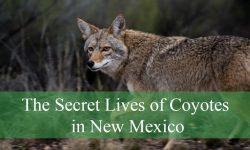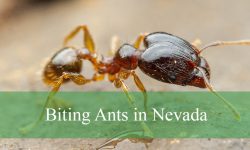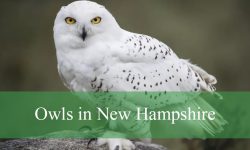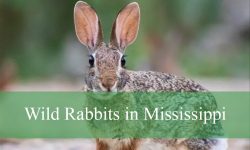Kentucky offers a rich and colorful variety of birdlife thanks to its diverse landscapes, ranging from dense forests and wetlands to open fields and rolling hills. This natural diversity supports hundreds of bird species, making birds in Kentucky a captivating subject for nature lovers and birdwatchers across the state.
Many people are drawn to the vibrant calls and striking plumage of local species, such as the Northern Cardinal, Eastern Bluebird, and Red-tailed Hawk. These and other birds in Kentucky can be spotted throughout the seasons, each adding their own character to the state’s ecosystems. From backyard feeders to state parks, opportunities to observe them are everywhere.
This article highlights 25 fascinating birds in Kentucky, complete with images and key identification tips. By learning more about these species, readers can gain a deeper understanding of Kentucky’s natural beauty and the important role birds play in its environment.
Common Types of Birds Found in Kentucky
Northern Cardinal
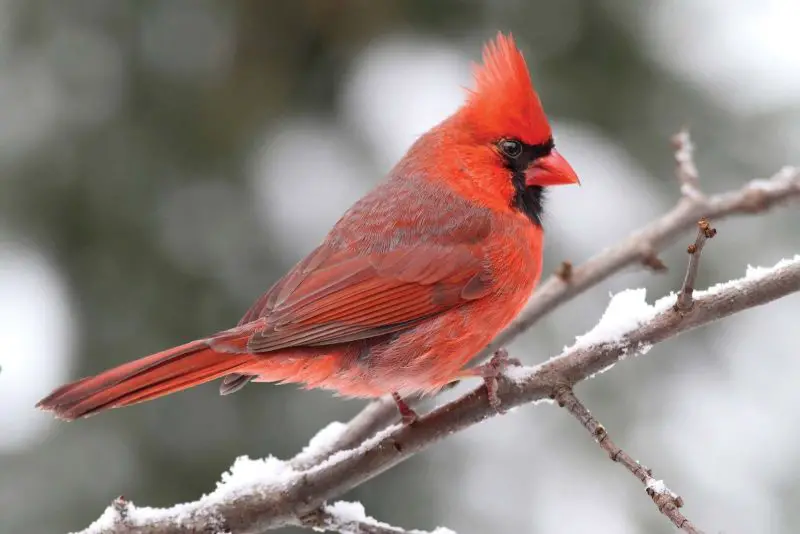
The Northern Cardinal is one of the most easily recognized and beloved birds in Kentucky, where it holds the status of the official state bird. The adult male is especially striking with its brilliant crimson-red plumage, contrasting sharply with a black mask around the face and a pointed crest atop the head. Females are more subdued in color, displaying warm brown tones with touches of red on the wings, tail, and crest. Both sexes have strong, cone-shaped orange-red beaks, ideal for cracking seeds. These medium-sized songbirds measure about 8 to 9 inches in length and are a familiar sight at backyard feeders across the state.
Northern Cardinals have a sweet, whistled song that varies by region and individual but often includes a cheerful series of repeated notes such as “cheer-cheer-cheer” or “birdie-birdie-birdie.” Males are especially vocal during the breeding season, using their songs to claim territory and attract mates. Cardinals are not shy birds and are active throughout the day. They exhibit year-round residency in Kentucky and do not migrate, making them a consistent presence even in winter when their red feathers stand out vividly against snowy landscapes.
Cardinals thrive in a wide variety of habitats, including woodlands, thickets, suburban gardens, and city parks. They are commonly found throughout all regions of Kentucky. Their diet consists mainly of seeds, fruits, and insects. They are frequent visitors to feeders, especially those stocked with sunflower seeds. These birds nest in dense shrubs or low trees, building cup-shaped nests and raising several broods during the warmer months. Their adaptability and beauty make them a cherished sight throughout the state.
American Robin
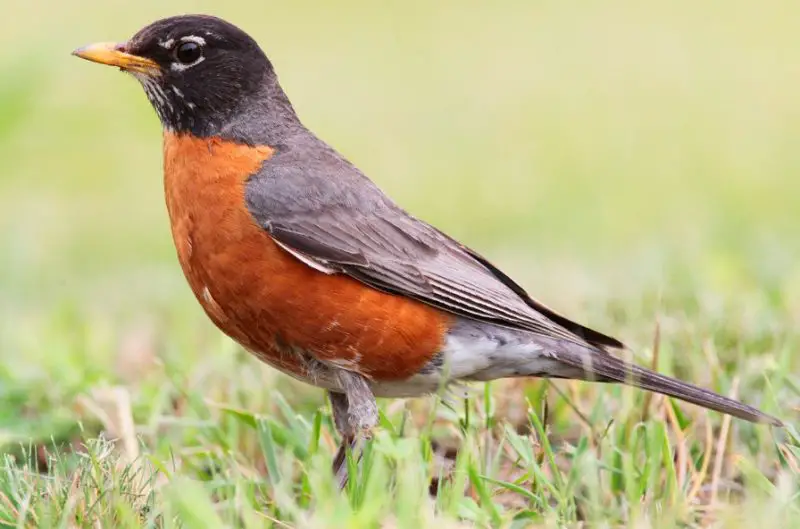
The American Robin is a familiar and widespread bird often associated with the arrival of spring in Kentucky. It is a medium-sized songbird measuring about 9 to 11 inches in length, with a rounded body and upright stance. Robins are easily identified by their warm orange-red bellies, gray-brown backs, and white throats streaked with black. They have a yellow bill and a distinctive white eye-ring. Both males and females look similar, though males may have slightly richer coloration.
Robins have a melodious and flute-like song, typically sung early in the morning. Their song consists of a series of clear whistles often described as “cheerily, cheer-up, cheer-up, cheerily.” They also make sharp alarm calls when threatened. Robins are known for their hopping gait and are often seen pulling earthworms from the ground with swift, decisive movements. During the breeding season, they become quite territorial, while in winter, they form large, nomadic flocks that move in search of fruiting trees.
American Robins are highly adaptable and can be found in a variety of habitats throughout Kentucky, including forests, fields, lawns, and urban areas. They are among the first birds to begin singing at dawn, often before sunrise. Their diet consists primarily of earthworms, insects, and a wide variety of fruits and berries. In Kentucky, robins are present year-round, though some individuals may migrate further south in harsh winters. They typically build cup-shaped nests in trees or on ledges, raising multiple broods each year.
Eastern Bluebird
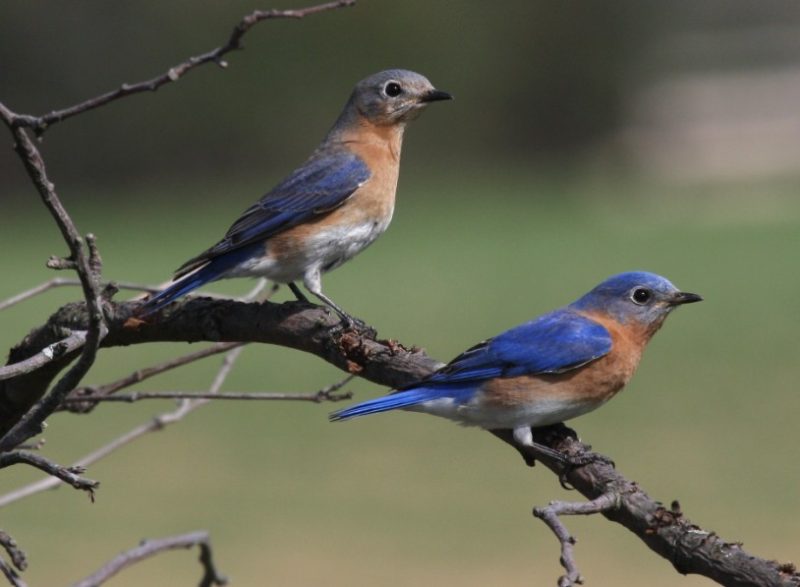
The Eastern Bluebird is a small, vividly colored songbird that brings a splash of brightness to Kentucky’s open spaces. Adult males boast a rich royal-blue back, wings, and head, with a contrasting rusty-orange throat and chest, and a white belly. Females are paler, with more subdued blue-gray tones and a similar orange breast. Bluebirds measure about 6.5 to 7 inches long and have slender, straight beaks suited for catching insects.
These birds have a soft, musical song composed of a series of warbled phrases, along with gentle calls that sound like “cheer” or “tru-ly.” Though not as loud as some other songbirds, the Eastern Bluebird’s voice adds a pleasant, melodious note to the countryside. Bluebirds are cavity nesters and will often take up residence in nest boxes, making them a favorite among bird watchers and conservationists. They are generally non-aggressive and exhibit gentle, social behavior, often perching conspicuously on fence posts and wires.
Eastern Bluebirds are most commonly found in open woodlands, meadows, orchards, and suburban areas throughout Kentucky. They favor areas with scattered trees and low ground cover, which support their insect-rich diet. Their primary food sources include beetles, caterpillars, crickets, and spiders, along with fruits and berries in the colder months. Thanks to widespread nest box programs, Eastern Bluebird populations in Kentucky have rebounded after previous declines, and they are now commonly spotted across the state during all seasons.
Carolina Chickadee
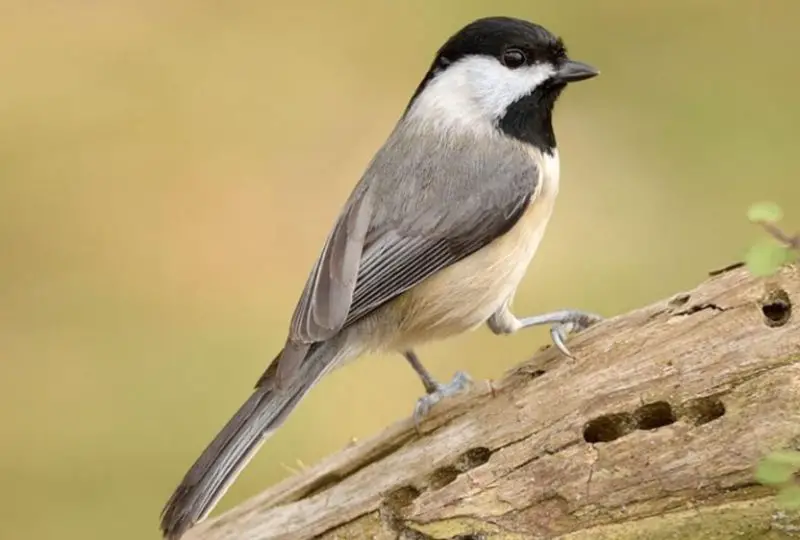
The Carolina Chickadee is a tiny, energetic bird known for its inquisitive nature and lively movements. Measuring just 4.5 to 5 inches in length, it features a distinctive black cap and bib, white cheeks, soft gray back and wings, and a pale underside. Despite its small size, the Carolina Chickadee has a bold presence and is frequently seen flitting among tree branches in search of food or exploring feeders in Kentucky backyards.
This bird’s vocalizations are varied and include its signature call, a clear four-note whistle that sounds like “fee-bee-fee-bay.” It also makes a familiar “chick-a-dee-dee-dee” call, which can change in intensity depending on the bird’s level of alarm. Chickadees are highly active and curious, often hanging upside down from branches or inspecting crevices for insects. They are non-migratory and maintain feeding territories year-round, often forming mixed-species flocks in winter for safety and foraging efficiency.
In Kentucky, the Carolina Chickadee is widespread across forests, woodland edges, parks, and residential areas. It primarily feeds on insects, spiders, seeds, and berries. During colder months, chickadees cache food to eat later, using excellent spatial memory to find their hidden stashes. They nest in tree cavities, including old woodpecker holes or artificial nest boxes. Their adaptability and charming personality make them a delightful sight throughout much of the state.
Tufted Titmouse
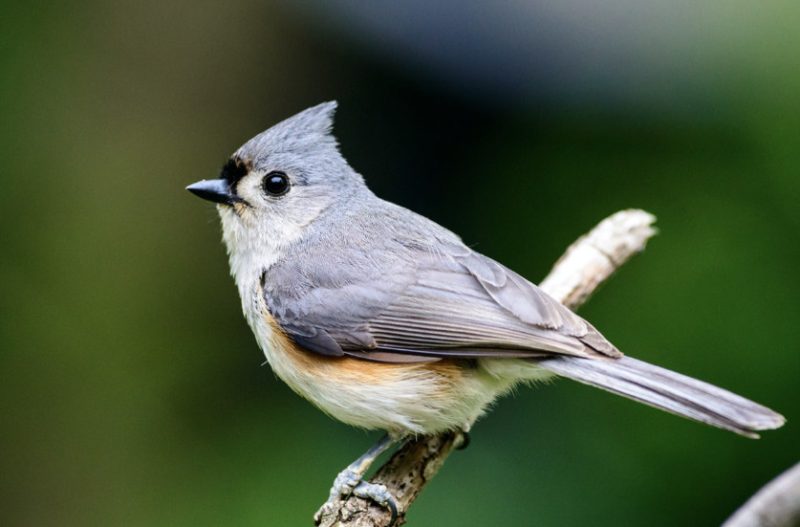
The Tufted Titmouse is a small, gray songbird known for its prominent crest and alert expression. Measuring about 5.5 to 6.5 inches in length, it has soft silvery-gray plumage above, white underparts, and a subtle wash of rusty peach on the flanks. The large, dark eyes and short, stout bill give it a round, expressive face. Its signature feature is the pointed crest atop the head, which it raises or lowers depending on its mood.
The Tufted Titmouse produces a loud, clear whistle that sounds like “peter-peter-peter,” repeated several times and often heard ringing through woodlands and suburbs alike. It also uses a variety of other calls, including harsh scolds and high-pitched chirps. Titmice are acrobatic foragers, frequently seen hopping through branches or hanging upside down to glean insects from leaves and bark. They are curious and sociable birds, often seen with chickadees and nuthatches in mixed flocks.
This species is a year-round resident in Kentucky and thrives in deciduous and mixed forests, as well as backyards with mature trees. The Tufted Titmouse feeds on insects, seeds, berries, and nuts, often visiting feeders for sunflower seeds and suet. It nests in natural cavities or birdhouses, lining the nest with soft materials, including fur or hair. Due to its adaptability and boldness, the Tufted Titmouse is one of the most commonly observed woodland birds in the state.
Red-tailed Hawk
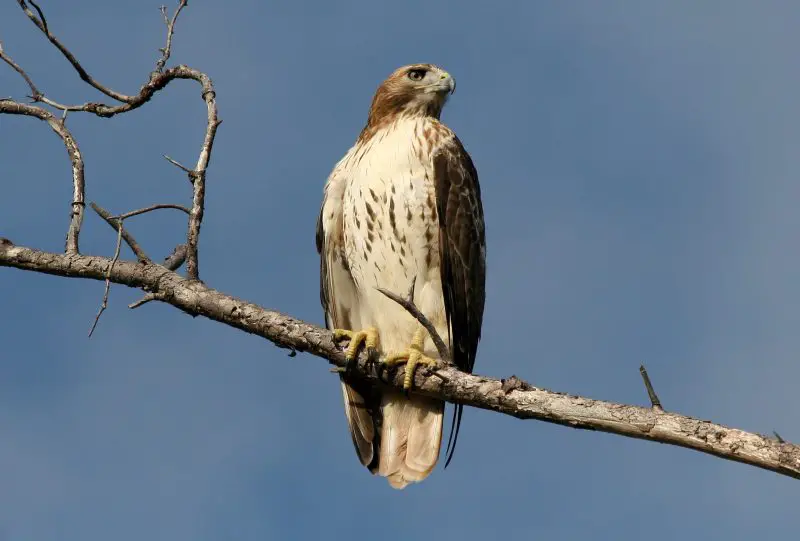
The Red-tailed Hawk is one of the most widespread and commonly seen birds of prey in Kentucky. It is a large raptor, measuring between 18 to 26 inches in length with a wingspan that can exceed four feet. Adult birds are typically brown above with a pale, streaked belly and a rich reddish-brown tail that gives the species its name. The tail color becomes more prominent as the bird matures, and young hawks initially have banded, brownish tails. They soar with broad, rounded wings and are often seen circling high in the sky or perched along roadsides on utility poles.
This species has a distinctive, harsh cry—described as a descending “kee-eeeee-arr”—that is frequently used in movies to represent all raptors. Red-tailed Hawks are keen hunters, using their excellent eyesight to scan for prey such as rodents, rabbits, snakes, and birds. They usually hunt from elevated perches or in slow, soaring flight. These hawks are territorial and may be seen alone or in pairs, especially during the breeding season. They are known for their impressive aerial displays and strong nest defense behavior.
Red-tailed Hawks can be found year-round throughout Kentucky in a wide range of habitats including open fields, forests, grasslands, and urban edges. They prefer areas with scattered trees or woodland borders where they can hunt effectively and nest securely. Their nests are large platforms of sticks, often built high in trees or on cliff ledges. This adaptable raptor plays a critical role in controlling rodent populations and is a majestic presence in Kentucky’s skies.
Bald Eagle
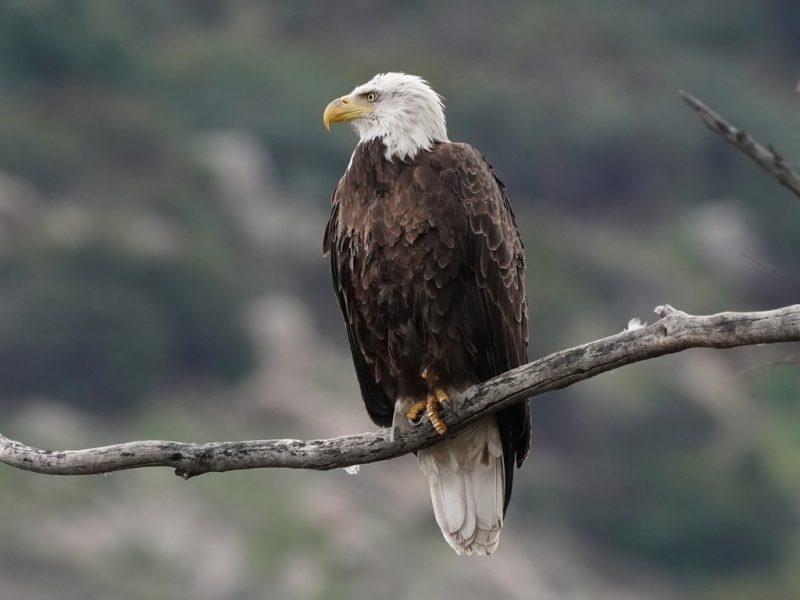
The Bald Eagle is an iconic symbol of the United States and a magnificent bird found across Kentucky, especially near major rivers and large lakes. Adult Bald Eagles are instantly recognizable with their white heads and tails contrasting against dark brown bodies and wings. Their yellow eyes, beak, and feet further stand out, and their impressive size—up to 40 inches in length with wingspans over 7 feet—makes them one of the largest raptors in North America. Juveniles, which lack the white head and tail, are mostly mottled brown and take several years to acquire full adult plumage.
Bald Eagles are known for their high-pitched, rapid calls, which sound surprisingly weak for such a powerful bird. Their vocalizations are often a series of short, whistling chirps. These eagles are skilled hunters and scavengers, feeding primarily on fish, but they will also take waterfowl, carrion, and small mammals when available. They often soar high above water bodies or perch prominently in large trees near shorelines, scanning for prey. Bald Eagles are known to steal food from other birds such as Ospreys.
In Kentucky, Bald Eagles have made a strong recovery and can now be found nesting along the Ohio River, Kentucky Lake, Lake Barkley, and other major waterways. They require tall, mature trees for nesting and roosting, and access to abundant fish supplies. Their nests are massive, often reused and added to for many years, and can reach weights of over a thousand pounds. Winter concentrations are particularly visible in western Kentucky, where eagles gather around open water and are celebrated through eagle-watching events.
Barred Owl
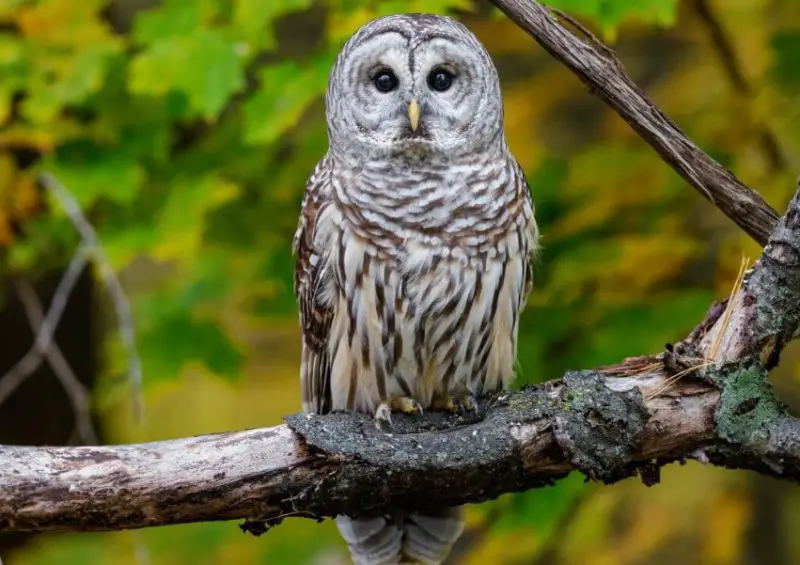
The Barred Owl is a medium-to-large owl commonly found in Kentucky’s wooded areas. It has a round head with no ear tufts, large dark eyes, and soft brown and white plumage with horizontal barring across the chest and vertical streaks on the belly. Adults measure around 17 to 20 inches in length and have broad wings that allow silent flight through dense forests. Its soft, mottled coloring helps it blend perfectly into tree bark, making it hard to spot during the day.
One of the most distinctive features of the Barred Owl is its haunting call, a loud and rhythmic hooting that sounds like “Who cooks for you? Who cooks for you-all?” This vocalization often echoes through the forest at night, especially during the breeding season. Barred Owls are primarily nocturnal but can also be active during the early morning or late evening hours. They hunt from perches, swooping down silently to capture prey such as rodents, small mammals, birds, amphibians, and invertebrates.
Barred Owls reside year-round throughout Kentucky in mature forests, wooded wetlands, and along river corridors. They prefer large tracts of uninterrupted forest, especially near water. These owls nest in natural tree cavities or abandoned hawk or crow nests. Unlike some other owl species, Barred Owls are quite vocal and may even respond to imitated calls. Their presence is often a sign of a healthy, mature woodland habitat, and they are commonly heard but not easily seen.
Eastern Screech-Owl

The Eastern Screech-Owl is a small yet charismatic owl that thrives in both wild and urban areas of Kentucky. Measuring only 6 to 10 inches in length, it has a compact body, a large head with ear tufts, and camouflage-like plumage in either gray or reddish-brown (rufous) morphs. The intricate patterns on their feathers make them nearly invisible when roosting in tree cavities during the day. These owls have yellow eyes and a short, hooked bill.
Despite their name, Eastern Screech-Owls do not produce loud screeches. Their call is a soft, tremulous trill or a descending whinny, often described as eerie or ghost-like. These calls are usually heard at night and are used to mark territory or attract mates. Screech-Owls are nocturnal and rely on stealth and surprise to catch prey. Their diet is highly varied, including insects, rodents, small birds, frogs, and even small reptiles. They often perch motionless, waiting to ambush unsuspecting prey.
This species is widespread across Kentucky and is commonly found in wooded suburbs, parks, orchards, and mature forests. They readily use nest boxes and are often heard more than seen. Eastern Screech-Owls are cavity nesters, favoring old woodpecker holes, tree hollows, and human-provided boxes. Their ability to live near people makes them one of the most accessible owls for bird watchers in Kentucky. Though small, they are fierce hunters and a vital part of the local ecosystem.
Mallard
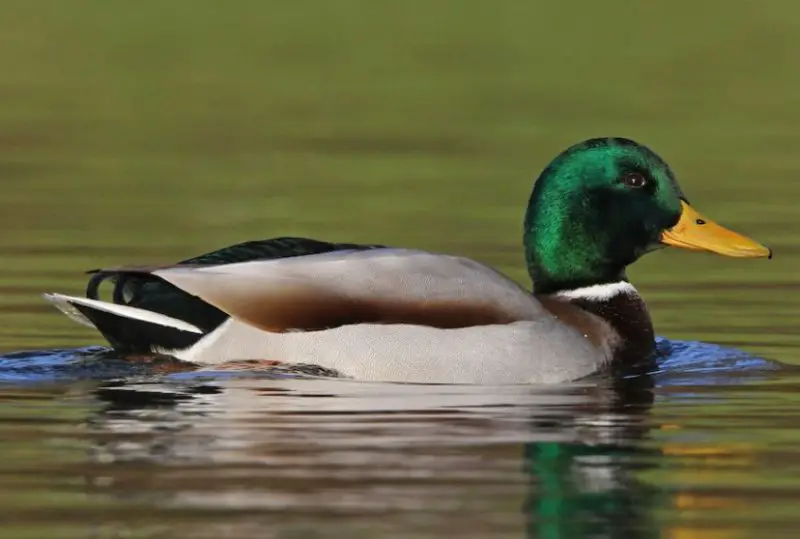
The Mallard is perhaps the most familiar and widely distributed wild duck in North America, and it is a common resident across Kentucky. Male Mallards, or drakes, are instantly recognizable with their glossy green heads, bright yellow bills, chestnut-brown chests, and grayish bodies. Females are mottled brown with orange bills marked with black, offering effective camouflage for nesting. Both sexes have a striking blue patch on the wing, called a speculum, bordered by white, which is visible in flight.
Mallards are vocal birds, with females producing the classic loud “quack” while males make softer, raspy calls. These ducks are strong fliers and adept swimmers, often seen dabbling on the surface of ponds, lakes, marshes, and rivers. They feed mainly on aquatic vegetation, seeds, insects, and small invertebrates. Mallards forage by tipping forward to reach underwater plants or by grazing on land. They are also common visitors to city parks and farm ponds where they may be fed by people.
In Kentucky, Mallards are year-round residents, though their numbers swell in the winter months due to migrating individuals from northern breeding grounds. They are found in virtually any wetland habitat, from remote marshes to urban lakes. Mallards nest on the ground in concealed locations near water, often raising broods in early spring. Their adaptability to human presence and broad diet have helped them become the most successful and widely recognized duck species across the state.
Wood Duck
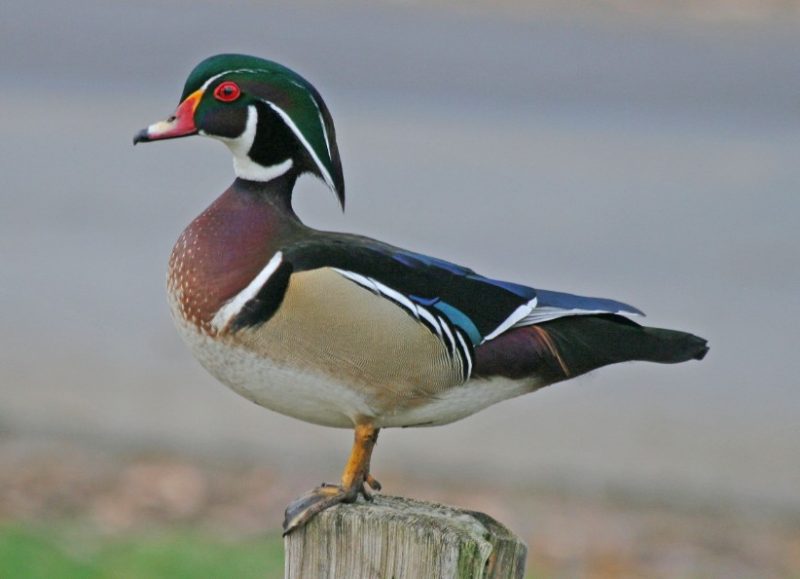
The Wood Duck is one of the most beautiful and colorful waterfowl species in North America and can be found in suitable habitats throughout Kentucky. Males are striking with iridescent green and purple heads, bold white markings along the face and neck, red eyes, and a chestnut-colored chest. Females are more subtly patterned, with a gray-brown body, white eye-ring, and slightly crested head. Both sexes have long tails and a sleek, elegant profile in flight. Adults typically measure 18 to 21 inches in length and have a wingspan around 28 to 30 inches.
Wood Ducks are known for their soft, high-pitched calls—females emit a loud, rising “oo-eek” call, especially when startled or during flight. These ducks are unique among North American waterfowl for their habit of nesting in tree cavities or nest boxes placed near water. Ducklings leap from high cavities soon after hatching, falling safely to the ground below. Their diet includes aquatic plants, insects, seeds, and acorns, and they feed by dabbling in shallow water or foraging on land.
In Kentucky, Wood Ducks are commonly found in wooded wetlands, flooded forests, swamps, and along slow-moving streams and ponds with abundant cover. They are most active during spring and summer breeding seasons but may be seen year-round in some areas with mild winters. Their strong association with forested water bodies makes them a key indicator of healthy wetland ecosystems. Thanks to conservation efforts, including the placement of nest boxes, Wood Duck populations have rebounded across the state.
Canada Goose
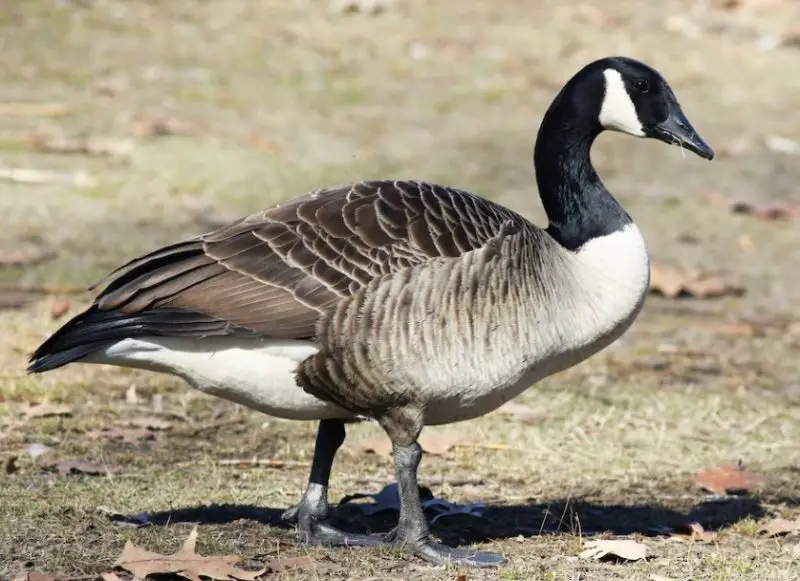
The Canada Goose is a large, easily recognized waterfowl species with a bold black head and neck, white chinstrap, and brownish-gray body. Adults typically measure 30 to 43 inches long with a wingspan of over five feet. These geese are known for their powerful flight and V-shaped migratory formations, which help reduce wind resistance and increase efficiency during long journeys. They are particularly vocal, with a distinctive honking call that echoes across open landscapes.
Canada Geese are adaptable birds found in both wild and human-altered environments. Their diet includes grasses, grains, aquatic vegetation, and even human food in urban areas. They feed on land or by dabbling in shallow water and are often seen grazing in parks, golf courses, and agricultural fields. Canada Geese form strong pair bonds and are highly protective parents during nesting season. They can be aggressive when defending their nests or young.
In Kentucky, Canada Geese are both migratory and year-round residents. Large flocks are commonly seen during fall and spring migrations, but breeding populations have become increasingly established in cities, suburbs, and farmlands with nearby water sources. They nest on the ground near lakes, rivers, and ponds, often returning to the same sites each year. These geese have successfully adapted to urban life and are now a regular sight in public parks and water bodies throughout the state.
Great Blue Heron
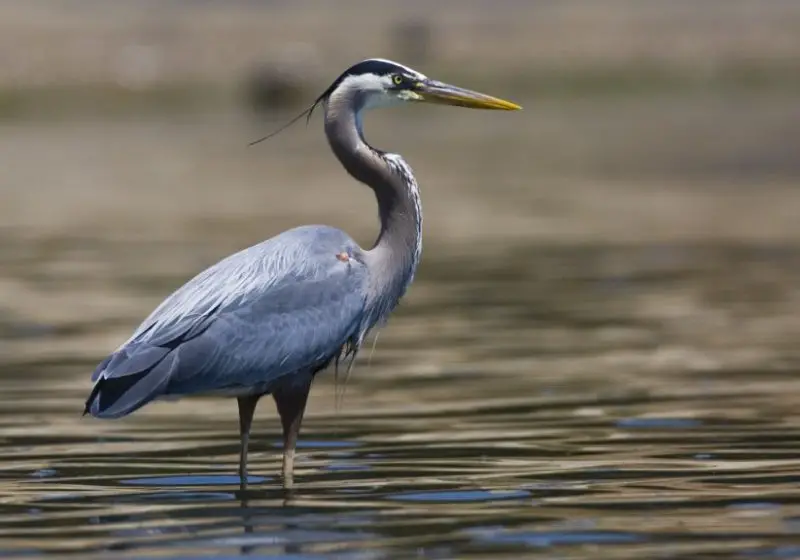
The Great Blue Heron is the largest heron species in North America and a familiar sight along Kentucky’s waterways. It stands 3.5 to 4.5 feet tall with a wingspan of nearly 6 feet. Its appearance is distinctive—tall and slender with a long neck, dagger-like yellow bill, and grayish-blue plumage. In flight, the heron’s neck is tucked in and its legs extend straight behind. Adults also have a shaggy plume on the chest and head.
Great Blue Herons are solitary hunters, often seen standing still at the water’s edge or slowly stalking prey. They feed mainly on fish but will also eat amphibians, insects, small mammals, and reptiles. With a swift thrust of their beak, they catch prey with impressive accuracy. Their call is a harsh, croaking “fraaank,” usually heard when taking off or during flight. Despite their size, they fly gracefully and are surprisingly quiet in motion.
In Kentucky, Great Blue Herons are widespread residents found in lakes, rivers, ponds, marshes, and even suburban creeks. They nest in colonies called rookeries, typically high in trees near water. While they can be seen year-round in most parts of the state, they are especially visible during warmer months. Their presence along water bodies signals healthy aquatic habitats and offers excellent bird-watching opportunities in both wild and urban areas.
Green Heron
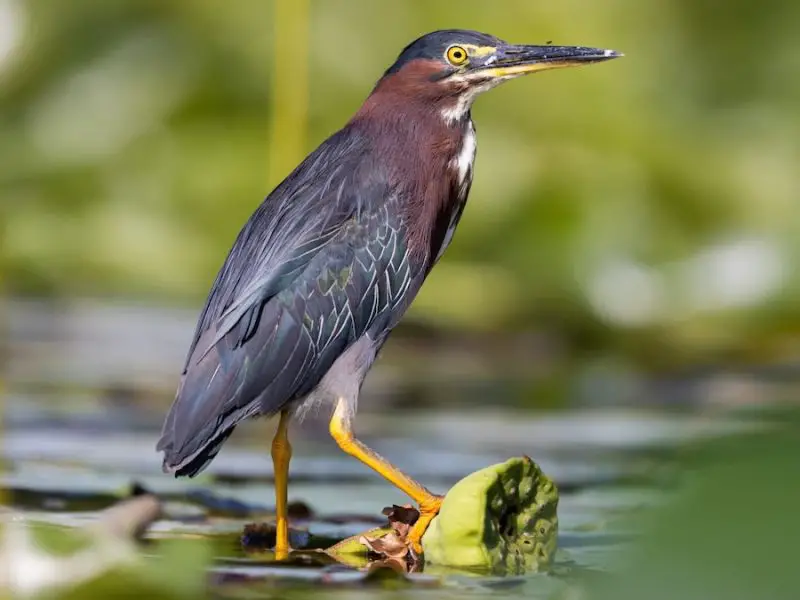
The Green Heron is a small but striking wading bird commonly found around Kentucky’s wetlands and wooded ponds. It measures around 16 to 18 inches in length with a wingspan just over two feet. This heron has a dark greenish-black cap, a chestnut neck and chest, and a dark back with a greenish sheen. It often hunches its neck close to the body, giving it a compact appearance. The bird’s legs are yellow to orange, and its sharp bill is well-suited for catching small prey.
Unlike larger herons, the Green Heron is secretive and often remains hidden along the edges of vegetation. It feeds on small fish, amphibians, insects, and crustaceans, using a unique hunting method that includes dropping bait (like insects or feathers) onto the water’s surface to lure fish—a rare example of tool use in birds. Its call is a loud, sudden “skeow” or sharp “kyow,” often heard when flushed from hiding.
In Kentucky, Green Herons are summer residents, found near marshes, slow-moving streams, forested ponds, and swamps. They nest in shrubs or trees near water, either alone or in small colonies. Because of their shy nature and excellent camouflage, they are often overlooked despite being fairly common. Bird watchers who spend time in quiet, overgrown wetland edges are more likely to observe these skillful and fascinating hunters during spring and summer.
Pileated Woodpecker

The Pileated Woodpecker is the largest woodpecker species in Kentucky and a striking bird of mature forests. Measuring about 16 to 19 inches in length with a wingspan up to 30 inches, it is roughly the size of a crow. The bird is mostly black with bold white stripes on the face and neck and large white patches on the underwings that are visible in flight. Its most noticeable feature is the flaming red crest atop its head, which gives it a prehistoric appearance.
Pileated Woodpeckers have a loud, resonant call—a series of sharp, laughing “kuk-kuk-kuk” notes—and a powerful drumming sound created by hammering on trees. They excavate large, rectangular holes in dead trees to forage for carpenter ants and beetle larvae, often leaving visible signs of their presence. Their feeding activity creates valuable nesting and roosting cavities for other species, including owls, bats, and smaller birds. They are usually seen alone or in pairs and are territorial throughout the year.
In Kentucky, Pileated Woodpeckers are year-round residents in large, mature deciduous or mixed forests, especially those with standing dead trees. They may also be found in wooded suburban areas and parks with sufficient habitat. Because of their loud calls and distinctive flight pattern—slow, deliberate wingbeats interspersed with glides—they are often heard before being seen. Their size, dramatic appearance, and behavior make them a favorite among bird watchers and nature enthusiasts across the state.
Downy Woodpecker
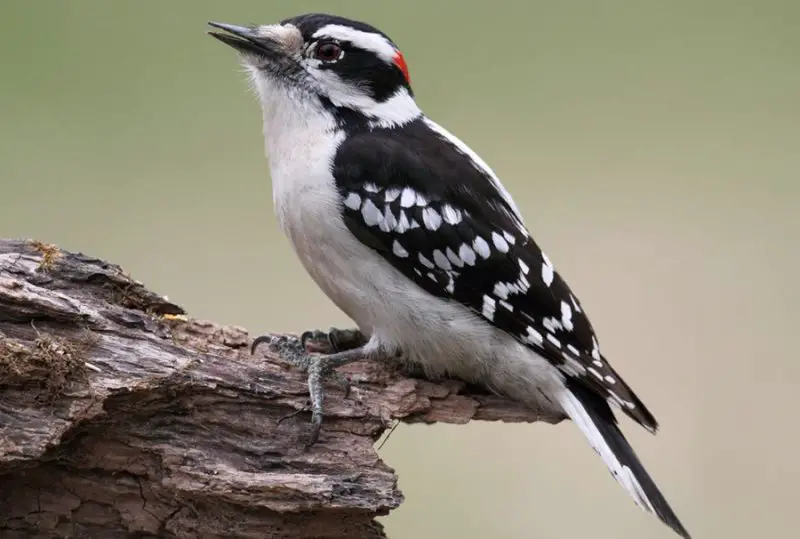
The Downy Woodpecker is the smallest woodpecker species in North America, and it’s a common sight across Kentucky, particularly at backyard bird feeders. This bird features a compact body about 5.5 to 7 inches long, with a black-and-white checkered pattern on its wings, a white underside, and a distinctive white stripe down the back. Males can be distinguished by a small red patch on the back of the head, which females lack. Despite its small size, it has a strong, chisel-like beak and a confident demeanor.
Its call is a sharp “pik” and a descending whinny, and it often drums rhythmically on tree trunks or metal poles. Downy Woodpeckers are highly active, hopping up tree trunks and branches in search of insects, especially beetle larvae, ants, and caterpillars. They also eat seeds and berries, making them regular visitors to suet and sunflower feeders. They can be seen alone or in mixed flocks during the non-breeding season, often mingling with chickadees and titmice.
In Kentucky, Downy Woodpeckers are found year-round in woodlands, parks, orchards, and residential areas. Their adaptability to a range of habitats—from deep forests to backyard gardens—makes them one of the most frequently observed woodpeckers in the state. They nest in tree cavities, which they excavate themselves, and are known for their tolerance of human presence, which contributes to their widespread popularity.
Red-bellied Woodpecker

The Red-bellied Woodpecker is a medium-sized woodpecker common throughout Kentucky, recognized more for its red head than its subtle reddish belly. Measuring about 9 to 10.5 inches in length, this bird has a striking black-and-white barred pattern across its back and wings, a pale face and underparts, and a bright red crown that extends from the bill to the nape in males (only to the crown in females). The reddish patch on the belly is often faint and difficult to see.
Its call is a loud, rolling “churr” and a sharp “querr,” often heard echoing through woodlands. Red-bellied Woodpeckers are bold and curious birds that forage by hitching along trunks and branches, prying off bark to find insects. They also consume fruits, nuts, and seeds and will visit bird feeders, especially for suet and peanuts. In fall and winter, they’re known to store food in tree crevices for later use.
In Kentucky, this woodpecker is a familiar year-round resident of deciduous forests, suburban neighborhoods, parks, and even wooded backyards. Despite the misleading name, their vivid red head and bold markings make them quite noticeable. They nest in dead trees or snags, and their loud vocalizations help defend territory and attract mates. Their adaptability and vocal nature have helped them thrive even in fragmented habitats.
Wild Turkey
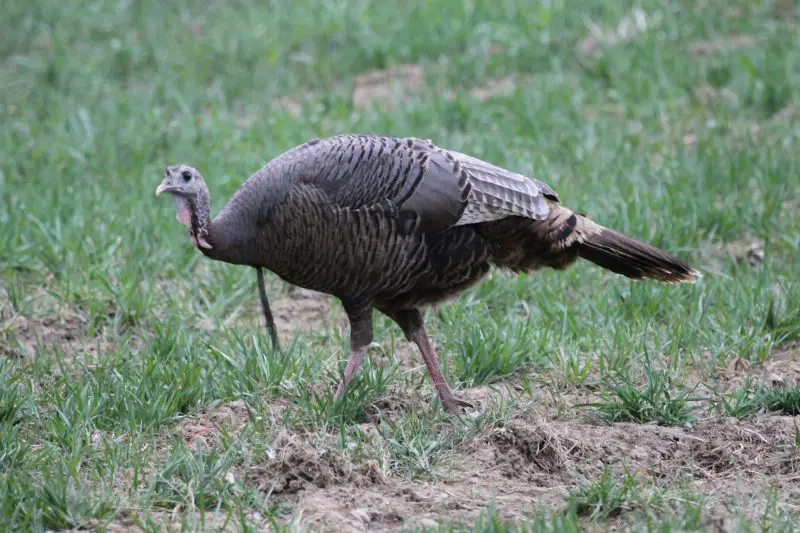
The Wild Turkey is one of the largest and most recognizable game birds in North America and is well-established across rural Kentucky. Adult males, called toms or gobblers, can reach up to 4 feet long and weigh over 20 pounds. They have dark, iridescent feathers with bronze and greenish highlights, a bald bluish head that can turn red when excited, and a fan-shaped tail. Females (hens) are smaller and duller in coloration. Males also sport a beard-like tuft of feathers on their chest and a fleshy snood over their beak.
Wild Turkeys are most vocal during spring, with the males emitting a booming “gobble” that echoes through forests to attract females. They also produce clucks, purrs, and yelps. These ground-dwelling birds forage in open woodlands, fields, and clearings for acorns, seeds, berries, insects, and small reptiles. Although heavy-bodied, they are agile flyers and can quickly take to the air when startled.
In Kentucky, Wild Turkeys are found throughout the state in forests, farm edges, and open woodlands. Reintroduction and conservation programs have greatly increased their numbers over the past few decades. They roost in trees at night and form flocks outside the breeding season. In rural areas, it’s not uncommon to see groups of turkeys crossing roads or foraging near fields, particularly during early morning or late afternoon.
Northern Bobwhite
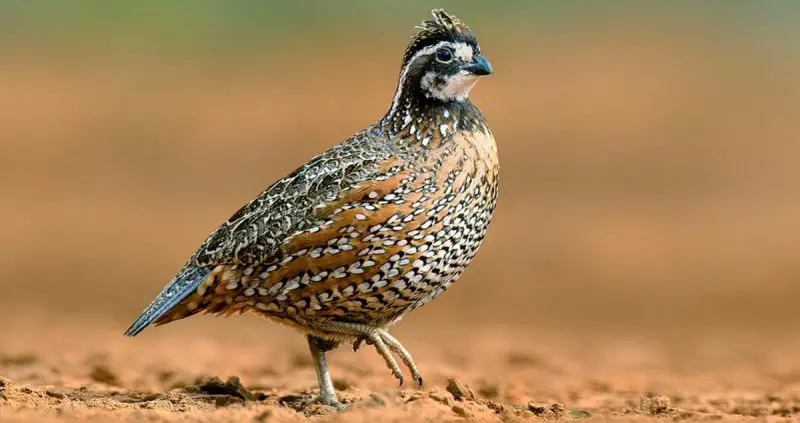
The Northern Bobwhite is a small, ground-dwelling quail well-known for its distinctive “bob-WHITE!” call, which gives the bird its name. Adults measure about 9 to 11 inches in length with a rounded body, short tail, and a mottled brown and white appearance that provides excellent camouflage. Males have a bold white throat and brow stripe bordered by black, while females display a more buff-colored face with less contrast.
These birds are usually heard before they are seen, especially during spring and summer when males call persistently from hidden perches. Northern Bobwhites feed on seeds, grains, and insects and are commonly found foraging in grassy fields, edges of woodlands, and overgrown pastures. They move in small groups known as coveys, staying close to the ground and flushing into short, rapid flight only when threatened.
In Kentucky, Northern Bobwhites were once abundant but have declined due to habitat loss and changes in farming practices. However, they are still found in rural areas with suitable grassland and edge habitat, particularly in the western and central parts of the state. Conservation efforts, including habitat restoration and prescribed burns, aim to help recover this iconic species of southern grasslands.
Mourning Dove
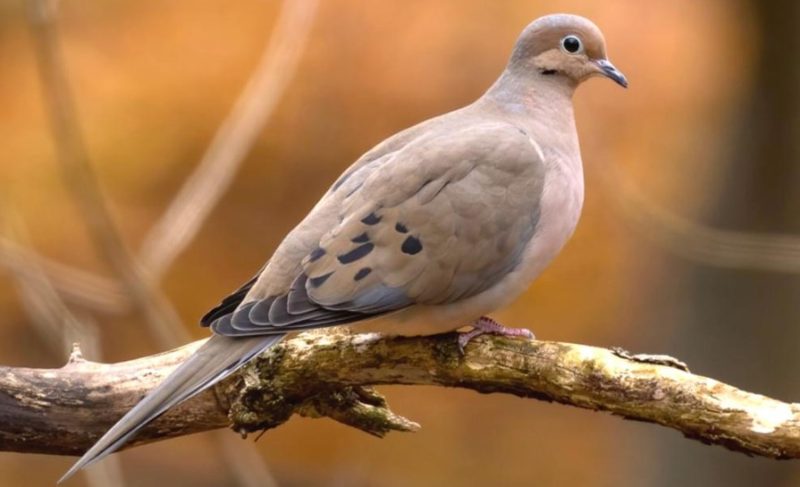
The Mourning Dove is a slender, medium-sized dove recognized for its soft grayish-brown plumage, small black spots on the wings, and long, pointed tail edged in white. Adults measure about 9 to 13 inches in length and have a gentle appearance with a small head and a quiet, subdued demeanor. Their name comes from their mournful, cooing song that sounds like “coo-OO-oo,” often heard in the early morning or evening.
These birds are strong and fast flyers, producing a sharp whistling sound with their wings when they take off. Mourning Doves feed primarily on seeds, which they find on the ground or at platform feeders. They are often seen perched on telephone wires, fence posts, or rooftops and prefer open or semi-open habitats such as fields, parks, and suburban gardens. They breed prolifically, often raising multiple broods per year.
In Kentucky, Mourning Doves are common year-round residents and can be found statewide in a variety of habitats. Their adaptability to human-altered environments makes them one of the most widespread and familiar birds in both urban and rural areas. They nest in trees, shrubs, or even on balconies, constructing flimsy platform nests. Their gentle presence and soothing song make them a welcome sight in any Kentucky landscape.
Blue Jay

The Blue Jay is one of Kentucky’s most vibrant and intelligent birds, easily identified by its brilliant blue plumage, white underparts, and distinct black necklace-like markings around the neck. Measuring about 9 to 12 inches in length, it has a prominent crest on its head and a sturdy black bill. The tail and wings show intricate patterns of blue, black, and white. Males and females look alike, making them difficult to distinguish visually.
Blue Jays are well known for their loud, varied calls, including harsh “jay-jay” sounds, whistles, and mimicry of hawks. They are curious and bold, often dominating feeders and chasing off smaller birds. Their intelligence is notable—they can use tools, cache food, and learn from observation. Blue Jays feed on acorns, nuts, seeds, insects, and occasionally bird eggs. Their powerful beaks help crack open hard-shelled seeds and nuts with ease.
In Kentucky, Blue Jays are common year-round residents of forests, suburban areas, and wooded parks. They are particularly fond of oak trees due to their reliance on acorns as a food source. These birds are often seen traveling in small family groups or mixed flocks and are known to form noisy gatherings, especially in the fall when acorns are abundant. Their presence is often announced by their bold voices and striking colors.
American Goldfinch
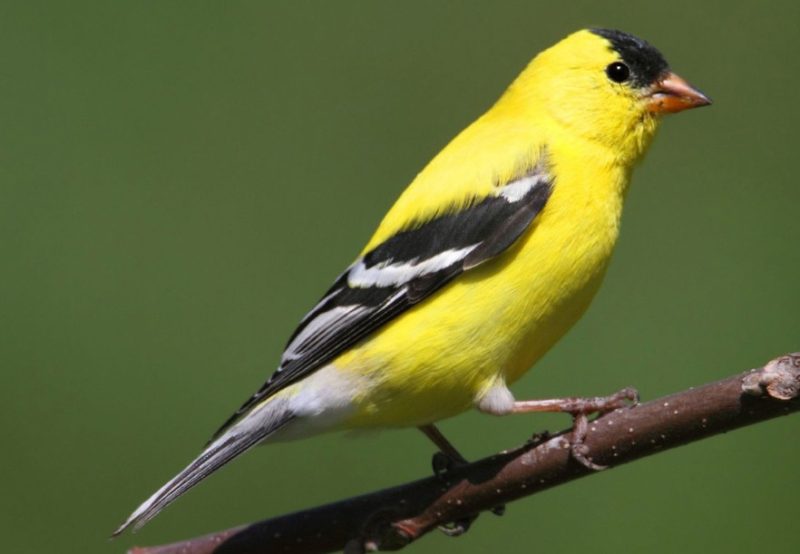
The American Goldfinch is a small, finch-like songbird renowned for its bright lemon-yellow breeding plumage and cheerful, bouncy flight. Adult males during summer are brilliant yellow with black wings and a black cap, while females are a more subdued olive-yellow. Outside of the breeding season, both sexes appear duller, with grayish-yellow tones. They measure about 4.5 to 5 inches long and have a short, conical bill ideal for seed-eating.
Their song is sweet and musical, often described as a “per-chick-o-ree” or “potato chip” call as they fly. Goldfinches feed primarily on seeds, especially from sunflowers, thistles, and dandelions, and are common visitors at feeders stocked with nyjer or black oil sunflower seeds. Their late nesting season, often in July or August, coincides with the peak abundance of seed-bearing plants.
In Kentucky, American Goldfinches are found throughout the year, though their numbers peak in summer and fall. They prefer open fields, meadows, and weedy areas, as well as suburban gardens and roadsides. These active birds often gather in small flocks and are especially visible in winter when their flitting movements and calls brighten quiet landscapes. Their diet and behavior make them particularly popular with backyard bird watchers.
Common Grackle

The Common Grackle is a large, blackbird-like species that is both glossy and gregarious, known for forming massive flocks and its shimmering, iridescent plumage. Measuring around 11 to 13 inches in length, it has a long, keel-shaped tail and a yellow eye that gives it an intense stare. Males have a glossy black body with hints of purple and blue on the head and bronze on the back, while females are duller but still iridescent.
Common Grackles have a wide variety of harsh, mechanical-sounding calls, including a distinctive “squawk” or “chack.” They are opportunistic omnivores, feeding on insects, seeds, grains, and even small animals like frogs or baby birds. In agricultural areas, they’re sometimes considered pests for raiding cornfields. They forage on the ground or in trees and are highly adaptable to human environments.
In Kentucky, Common Grackles are found year-round, especially in open fields, wetlands, city parks, and suburban areas. During migration and winter, they often gather in enormous flocks with other blackbirds and starlings, creating dramatic displays in the sky and loud communal roosts. Their bold behavior and striking plumage make them both noticeable and sometimes controversial visitors to feeders and farmlands alike.
Ruby-throated Hummingbird
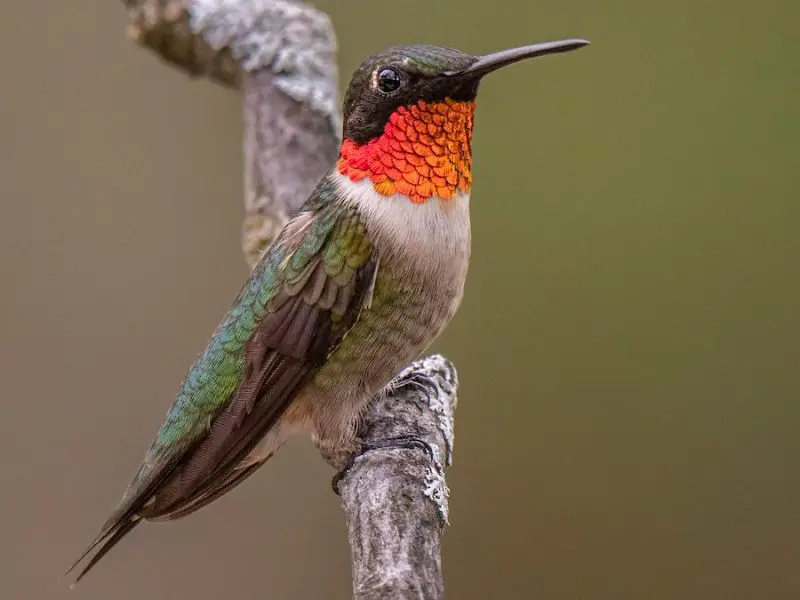
The Ruby-throated Hummingbird is Kentucky’s only breeding hummingbird and a marvel of aerial agility and vibrant color. These tiny birds measure only 3 to 3.5 inches in length and weigh less than a nickel. Males are particularly eye-catching with their iridescent emerald green backs and bright ruby-red throat, while females are green above with a pale, unmarked throat. Their wings beat about 50 times per second, allowing them to hover and fly in all directions.
Despite their size, Ruby-throated Hummingbirds are fierce and territorial. Their call is a rapid, chattering “tik-tik” sound, and their flight produces a faint humming noise. They feed primarily on nectar from tubular flowers and sugar water from feeders, supplemented with small insects and spiders for protein. Their long migration includes a non-stop flight across the Gulf of Mexico in spring and fall.
In Kentucky, these hummingbirds are common from mid-April through early October. They prefer gardens, wood edges, meadows, and any habitat with flowering plants. Homeowners often attract them with red or orange flowers like trumpet vine, bee balm, or salvia. Ruby-throated Hummingbirds are beloved for their dazzling appearance and dynamic flight patterns, marking the arrival of spring across the state.

